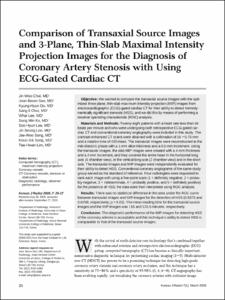Comparison of Transaxial Source Images and 3-Plane, Thin-Slab Maximal Intensity Projection Images for the Diagnosis of Coronary Artery Stenosis with Using ECG-Gated Cardiac CT
- Affiliated Author(s)
- 고성민
- Alternative Author(s)
- Ko, Sung Min
- Journal Title
- Korean Journal of Radiology
- ISSN
- 1229-6929
- Issued Date
- 2006
- Keyword
- Computed tomography (CT); maximum intensity projection; Coronary vessels; CT Coronary vessels, stenosis or obstruction; Diagnostic radiology, observer performance
- Abstract
- Objective:
We wanted to compare the transaxial source images with the optimized three plane, thin-slab maximum intensity projection (MIP) images from electrocardiographic (ECG)-gated cardiac CT for their ability to detect hemodynamically significant stenosis (HSS), and we did this by means of performing a receiver operating characteristic (ROC) analysis.
Materials and Methods:
Twenty-eight patients with a heart rate less than 66 beats per minute and who were undergoing both retrospective ECG-gated cardiac CT and conventional coronary angiography were included in this study. The contrast-enhanced CT scans were obtained with a collimation of 16×0.75-mm and a rotation time of 420 msec. The transaxial images were reconstructed at the mid-diastolic phase with a 1-mm slice thickness and a 0.5-mm increment. Using the transaxial images, the slab MIP images were created with a 4-mm thickness and a 2-mm increment, and they covered the entire heart in the horizontal long axis (4 chamber view), in the vertical long axis (2 chamber view) and in the short axis. The transaxial images and MIP images were independently evaluated for their ability to detect HSS. Conventional coronary angiograms of the same study group served as the standard of reference. Four radiologists were requested to rank each image with using a five-point scale (1 = definitely negative, 2 = probably negative, 3 = indeterminate, 4 = probably positive, and 5 = definitely positive) for the presence of HSS; the data were then interpreted using ROC analysis.
Results:
There was no statistical difference in the area under the ROC curve between transaxial images and MIP images for the detection of HSS (0.8375 and 0.8708, respectively; p > 0.05). The mean reading time for the transaxial source images and the MIP images was 116 and 126.5 minutes, respectively.
Conclusion:
The diagnostic performance of the MIP images for detecting HSS of the coronary arteries is acceptable and this technique's ability to detect HSS is comparable to that of the transaxial source images.
- Department
- Dept. of Radiology (영상의학)
- Publisher
- School of Medicine
- Citation
- Jin Woo Choi et al. (2006). Comparison of Transaxial Source Images and 3-Plane, Thin-Slab Maximal Intensity Projection Images for the Diagnosis of Coronary Artery Stenosis with Using ECG-Gated Cardiac CT. Korean Journal of Radiology, 7(1), 20–27. doi: 10.3348/kjr.2006.7.1.20
- Type
- Article
- ISSN
- 1229-6929
- Appears in Collections:
- 1. School of Medicine (의과대학) > Dept. of Radiology (영상의학)
- 파일 목록
-
-
Download
 oak-aaa-2335.pdf
기타 데이터 / 3.78 MB / Adobe PDF
oak-aaa-2335.pdf
기타 데이터 / 3.78 MB / Adobe PDF
-
Items in Repository are protected by copyright, with all rights reserved, unless otherwise indicated.